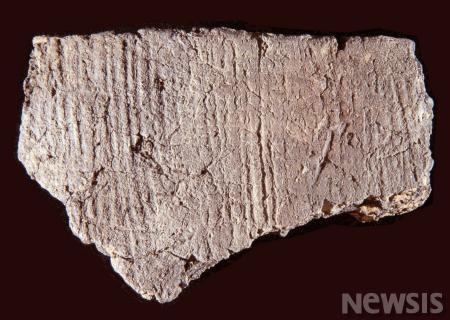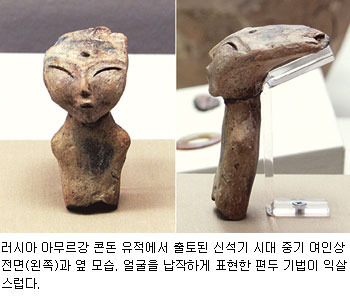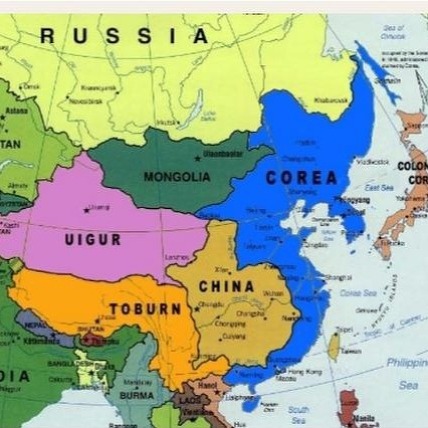력사를 찾아서
B.C.1만3000년 전의 세계 최고(最古) 토기편 본문

문화재청 국립문화재연구소는 2006년 11월1일부터 12월3일까지 고궁박물관 기획전시실에서 한.러 공동발굴특별전 '아무르.연해주의 신비'를 열었다.
사진은 아무르강 하류 가샤유적에서 출토된 고토기편(古土器片)으로, 방사성탄소연대 12,960±120B.P.로 측정된 세계 최고(最古)의 토기편이다.
■ B.C.1만3000년 전의 세계 최고(最古) 토기편

【서울=뉴시스】
지난 6년간 러시아와 공동으로 아무르강 유역과 연해주 일대에서 발굴조사한 유물들을 전시하는 이 특별전은 우리 민족의 원류를 밝히고 선사시대에서 발해로 이어지는 양 지역 상호 문화교류 양상을 이해하고자 추진된 양국 공동발굴조사의 결과물로, 러시아 극동지역의 신석기시대에서 발해, 여진까지의 고고유물과 현지 원주민의 민속유물 총 393점이 전시된다.(1)
뉴시스, 김선아기자, B.C.1만3000년 전의 세계 최고(最古) 토기편, 2006. 10. 30.
경복궁 내 국립고궁박물관에서 2006년 11월 1일부터 12월 3일까지 열린 '아무르·연해주의 신비' 전에는 문화재청 산하 국립문화재연구소가 2000년부터 올해까지 러시아과학원 시베리아지부 고고학민족학연구소와 공동 발굴한 아무르강 하류 수추섬과 연해주 불로치카의 유물을 포함해 러시아 극동지역의 신석기시대부터 발해·여진까지의 유물 등 총 393점이 전시되었다.
■ 세계最古 토기 한국 나들이... 아무르 신비전
2006. 10. 30.

'아무르의 미케네'로 불리는 아무르강 수추섬 유적에서는 신석기시대 초기에서 후기에 이르는 주거지와 토기 및 인물상 등 2만여점의 유물이 출토됐다.
특히 토기는 방사성 탄소연대 측정결과 지금으로부터 1만2960±120년 전이라는 연대가 검출돼 세계 최고로 인정받았으며 인물상은 외계인을 연상시키는 외모로 눈길을 끈다.
또 두만강에서 멀지 않은 연해주의 동해안에 위치한 불로치카 유적에서는 총 23기의 주거지에서 신석기시대부터 발해에 이르는 다양한 유물이 출토됐다. 이 가운데 옥저(沃沮)의 '돌상자형' 온돌은 우리 민족 고유의 문화인 온돌의 기원을 밝힐 수 있다는 점에서 학술적 가치가 높다. 이밖에 각종 철기시대 유물들은 발해 형성 이전의 문화상을 잘 보여주며 아무르 지역의 말갈·여진문화는 연해주의 발해문화와 비교된다.
홍형우 문화재연구소 학예연구관은 "한·러 공동발굴단의 성과를 한국에서 처음 공개하는 전시"라면서 "한국 문화의 원류 가운데 하나인 아무르·연해주 일대 문명과의 관련성을 보여준다는 점에서 의미가 깊다"고 말했다.
국민일보, 장지영 기자, 세계最古 토기 한국 나들이.. 내일부터 아무르 신비전, 2006. 10. 30.
<자료출처>
(1) B.C.1만3000년 전의 세계 최고(最古) 토기편
(2) 세계最古 토기 한국 나들이.. 내일부터 아무르 신비전
<참고자료>
Ōdai Yamamoto I Site - Wikipedia
https://doi.org/10.1016/j.quaint.2016.10.011
Abstract
Patterns for the emergence of pottery-making in greater East Asia based on radiocarbon dates associated with the earliest pottery assemblages are presented.
According to a critical evaluation of the existing evidence, the oldest centers with pottery in East Asia are located in South China (dated to ca. 18,000 cal BP), the Japanese Islands (ca. 16,700 cal BP), and the Russian Far East (ca. 15,900 cal BP).
The claim for earlier pottery in South China at the Xianrendong Cave, supposedly dated to ca. 20,000 cal BP, cannot be substantiated.
The appearance of pottery in other parts of greater East Asia was a slow process, without clear diffusion from any of these centers toward the periphery.
In neighboring Siberia, the oldest pottery dated to ca. 14,000 cal BP is known from the Transbaikal.
https://www.sciencedirect.com/science/article/pii/S1040618216302567
https://doi.org/10.1016/j.quaint.2016.10.035
https://www.sciencedirect.com/science/article/pii/S1040618216304384
https://link.springer.com/chapter/10.1007/978-1-4939-6521-2_22
'현생인류출현~1만년전 > 문명의 시작' 카테고리의 다른 글
| 1만4500년전 빵 흔적 발견…선사시대 빵 맛은 (12) | 2025.03.14 |
|---|---|
| 1만2500년前 한강유역서… 인류 최초 ‘쌀·콩·깨 재배’ 시작됐다 (17) | 2025.03.13 |
| 홀연히 나타난 1만5000년전 '청주 소로리 볍씨'의 정체 (13) | 2025.03.13 |
| "흑피옥 연대 1만 4000년, 인류 최고 문명" (10) | 2025.03.13 |
| 9000년 전 인류 조상, '화장 장례' 치렀다..화장터 발견 (27) | 2025.03.12 |





